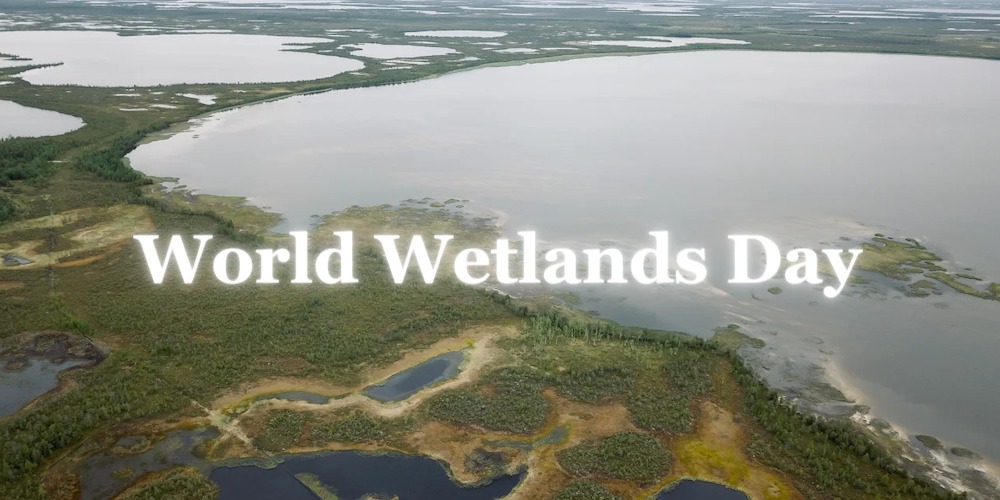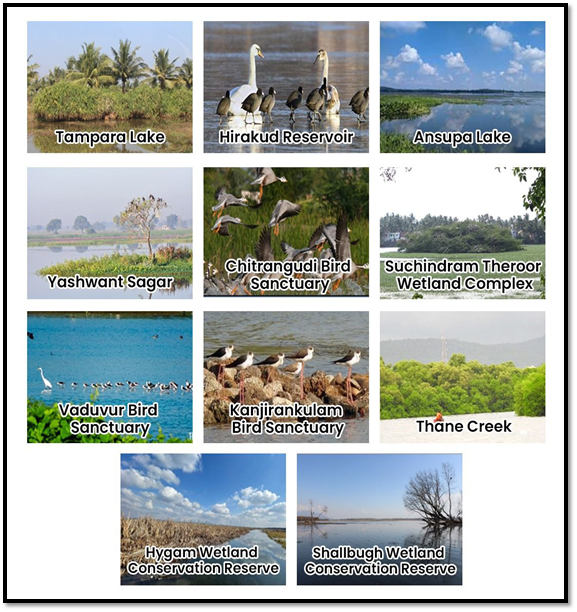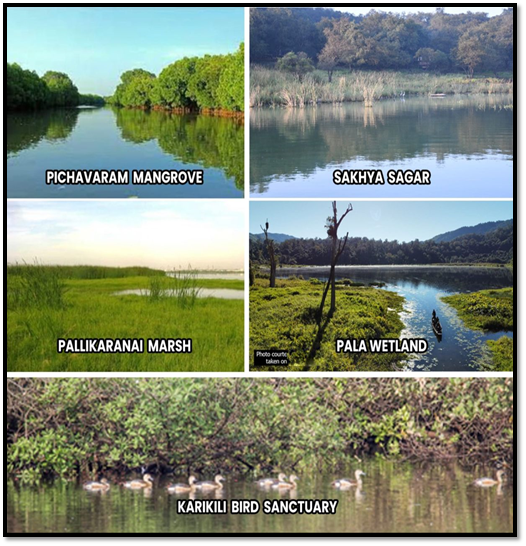Safeguarding the Ecosystems

“Wetlands are very important for the existence of our earth, because many birds and animals depend on them. Along with enriching Biodiversity, they also ensure flood control and groundwater recharge.” – Prime Minister Narendra Modi
The world celebrated World Wetlands Day on February 02.
Wetlands are crucial ecosystems, disappearing rapidly due to human activities such as drainage, pollution, and overexploitation. This loss has profound implications for biodiversity, climate, and economies worldwide. To address this, there’s a need to change perceptions and prioritise wetland conservation. Raising awareness, particularly while remembering the World Wetlands Day, is essential to catalyse action and safeguard these vital ecosystems.
World Wetlands Day, observed annually on February 2nd, raises awareness about wetlands and commemorates the adoption of the Convention on Wetlands in 1971. This international treaty provides a framework for wetland conservation and wise use. The significance of World Wetlands Day was emphasised in 2022 with the adoption of Resolution 75/317 by the UN General Assembly, establishing it as a global observance.

World Wetlands Day 2024
World Wetlands Day 2024 focuses on the theme ‘Wetlands and Human Wellbeing,’ highlighting the critical role wetlands play in enhancing our lives by providing flood protection, clean water, biodiversity, and recreational opportunities essential for human health and prosperity. This year, the Ministry of Environment, Forest & Climate Change (MoEF&CC), Government of India, in collaboration with the Government of Madhya Pradesh, organised the national World Wetlands Day event at Sirpur Lake, Indore, a Ramsar site designated in 2022.
Last year, the Government of India had launched the The ‘Save Wetlands Campaign (SWC) and structured a “whole of society” approach for wetlands conservation, enabling affirmative actions for wetlands conservation at all levels of the society and involving all strata of the society. All this has led to encouraging results. The campaign inter-alia, envisaged to include sensitising people of the value of wetlands, increasing the coverage of Wetland Mitras and building citizen partnerships for wetlands conservation amongst other targets.
Wetlands hold significant cultural and traditional importance in India, with revered sites like Loktak Lake and Khecheopalri Lake. The country’s diverse wetlands attract tourists and find mention in ancient texts like Chanakya’s Arthashastra. India has made strides in wetland conservation, boasting the largest network of Ramsar Sites in South Asia, covering 1.33 million hectares. These sites contribute significantly to biodiversity, hosting 6200 species across various faunal groups. India’s wetlands serve as crucial stopovers for millions of migratory birds, playing a vital role in maintaining waterbird populations globally. Despite global threats, India is reversing the trend of shrinking wetlands through legal protections and conservation efforts.
India’s commitment to wetland conservation continues to strengthen with recent milestones marking significant progress. In January 2024, India proudly expanded its Ramsar Site count to 80 by designating five new sites in Karnataka and Tamil Nadu, showcasing its dedication to preserving invaluable ecosystems.
This achievement builds upon the momentum set in August 2022 when India added 11 wetlands to its roster, a poignant gesture commemorating the nation’s 75th year of Independence. Additionally, the Wetlands of India Portal serves as a knowledge hub for wetland managers and stakeholders, providing comprehensive information and resources.
Over the last 12 months, aligning with the Mission Lifestyle for Environment (LiFE) and following the philosophy of Mission Sahbhagita of MoEF&CC, the campaign has been implemented at a Pan-India level, across all districts. The network of Ramsar Sites served as model sites or anchors for their respective States/UTs. State Wetland Authorities, District Administrations, Municipal Corporations, Gram Panchayats, Educational Institutes, and Knowledge Partners have been active participants in the campaign.

Targets and achievements under ‘Save Wetlands Campaign’
Activities Target Achieved
Ground truthing of wetlands 50000 77087
Wetland health cards 5000 6248
Wetland Mitras 20000 766938*
Sensitization of citizens 1000000 1988355
Multi-stakeholder partnerships
for wetlands conservation 100 118
*The number includes mitras registered and people taken pledge to be Wetland Mitra.
Apart from these achievements, more than 6400 events were conducted throughout the year to engage citizens and sensitize them in wetlands management and conservation. These events included wetland cleaning drives, painting competitions, pledge taking ceremonies, sensitization workshops and seminars, involving Wetland Mitras and school & college students across different states/UTs. These activities were continuously monitored on a real-time basis through a dedicated dashboard on the Wetlands of India portal.
A focused social media campaign was also conducted to raise mass awareness about the importance of wetlands in daily life including the unique conservation values of the Ramsar Sites across the country. Over three months the social media campaign through Instagram, X, and Facebook could reach out to over 1 million citizens. Encouraged with the commendable participation by all states/UTs and their cooperative engagement with the MoEF&CC, the Government of India has decided to continue the activities within the SWC, in line with the principle of ‘Conservation through participation and prosperity through conservation’.
Furthering this ‘whole of society’ and ‘whole of Government’ approach of Sahbhagita, the activities delineated under the Amrit Dharohar initiative have also been instrumental in promoting the Save Wetlands Campaign. Under Amrit Dharohar, the MoEF&CC has collaborated with Ministry of Tourism (MoT) for enhancing nature tourism around Ramsar Sites, Central Institute of Educational Technology (CIET), a nodal agency of the National Council of Educational Research and Training (NCERT) under the Ministry of Education (MoE) for developing digital educational content for school students across the country, National Museum for Natural History (NMNH), and Eco-Clubs under the National Green Corps programme for engaging school and college students in different activities and raising mass awareness.
Since the launch of Amrit Dharohar on World Environment Day 2023, more than 600 People’s Biodiversity Registers (PBRs) around the Ramsar Sites were updated engaging the local Biodiversity Management Committees (BMCs). Also, floral and faunal inventory of 75 Ramsar Sites were developed by Botanical Survey of India (BSI) and Zoological Survey of India (ZSI) respectively as part of the activities under Amrit Dharohar. The floral inventory includes list of plants of 75 Ramsar Sites including several economically and medicinally important species along with some threatened and endemic species of flora. The faunal inventory includes lists of faunal species available in the Ramsar Sites including endangered, endemic and migratory species.
On the other hand, MoEF&CC in collaboration with the MoT developed curriculum for training programs on nature tourism and wetlands livelihoods to enhance livelihood opportunities for local communities by harnessing the nature-tourism potential of the Ramsar Sites across the country. During November 2023 – January 2024, 196 local community members from five Ramsar Sites i.e. Sultanpur National Park in Haryana, Sirpur Lake & Yashwant Sagar in Madhya Pradesh, and Bhitarkanika Mangroves & Chilika Lake in Odisha were trained on Alternate Livelihood Program (ALP)/Paryavaran Naavik Certificate (PNC) and subsequently certified as nature-guides. Also, in collaboration with CIET-NCERT, MoEF&CC has created a series of educational videos focusing on different levels of school students on the importance of wetlands conservation and management.

Moreover, in the run up to the World Wetlands Day 2024, a series of activities were conducted in collaboration with NMNH and EIACP, reaching out to more than 1.6 lakhs students through the eco-clubs in schools and colleges. Four national level competitions, Nukkad Natak, Painting, Photography and Slogan writing, were also conducted by NMNH and MyGov based on this year’s World Wetlands Day (WWD) theme of ‘Wetlands and human wellbeing’.
As part of Mission Sahbhagita, several consultative workshops were also organized with the State/UT Wetlands Authorities. Based on the inputs received from the SWAs/UTWAs, the Guidelines for implementation of National Plan for Conservation of Aquatic Ecosystems (NPCA) have now been revised to introduce a Framework Management Plan, wherein the states can seek funds for designing management plans, as well as initiating implementation based on ‘no-regret’ actions. These guidelines were launched during WWD 2024 and will enable States and UTs to bring more wetlands under the coverage of integrated management.
Additionally, with increased public awareness on wetlands management and conservation, India, for the first time, has submitted nomination to the Ramsar Secretariat for the inclusion of three cities, Bhopal and Indore in Madhya Pradesh and Udaipur in Rajasthan, as Wetlands Cities under the voluntary Ramsar Wetland City Accreditation scheme under the Ramsar Convention.
About Mission Sahbhagita
Ministry of Environment, Forest and Climate Change (MoEF&CC) launched Mission Sahbhagita in 2022 with a mission of ‘a healthy and effectively managed network of wetlands of national and international significance which support water and food security; buffer from floods, droughts, cyclones and other extreme events; employment generation; conservation of species of local, national and international significance; climate change mitigation and adaptation actions; and recognition, conservation and celebration of cultural heritage.’
About Amrit Dharohar
Amrit Dharohar initiative, part of the 2023-24 budget announcement, was launched by MoEF&CC during June 2023 to promote unique conservation values of the Ramsar Sites in the country while generating employment opportunities and supporting local livelihoods. This initiative is to be implemented in convergence with various Central Government ministries and agencies, State Wetland Authorities, and a network of formal and informal institutions and individuals, working together for a common cause.
About Wetland City Accreditation
Recognizing the importance of wetlands in urban and peri-urban environments and to take appropriate measures to conserve and protect these wetlands, the Ramsar Convention during COP12 held in the year 2015 approved a voluntary Wetland City Accreditation system under Resolution XII.10 which recognizes cities which have taken exceptional steps to safeguard their urban wetlands. The Wetland City Accreditation scheme aims to further promote the conservation and wise use of urban and peri-urban wetlands, as well as sustainable socio-economic benefits for local populations. Additionally, the Accreditation seeks to encourage cities that are close to and dependent on wetlands, primarily Wetlands of International Importance, but also wetlands with other conservation category status, to develop and strengthen a positive relationship with these valuable ecosystems. To be formally accredited, a candidate for the Wetland City Accreditation should satisfy the standards used to implement each of the six international criteria mentioned Operational Guidance for WCA of the Ramsar Convention on Wetlands. This voluntary scheme provides an opportunity for cities that value their natural or human-made wetlands to gain international recognition and positive branding opportunities for their efforts in demonstrating strong positive relationships with wetlands.


